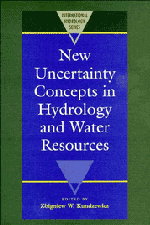Book contents
- Frontmatter
- Contents
- List of Authors
- Preface
- I INTRODUCTION
- II FACETS OF UNCERTAINTY
- III NOVEL APPROACHES TO UNCERTAINTY: FRACTALS, FUZZY SETS AND PATTERN RECOGNITION, NON-PARAMETRIC METHODS
- 1 Dispersion in stratified soils with fractal permeability distribution
- 2 Multifractals and rain
- 3 Is rain fractal?
- 4 Multifractal structure of rainfall occurrence in West Africa
- 5 Analysis of high-resolution rainfall data
- 6 Application of fuzzy theory to snowmelt runoff
- 7 On the value of fuzzy concepts in hydrology and water resources management
- 8 Application of neural network in groundwater remediation under conditions of uncertainty
- 9 Application of pattern recognition to rainfall–runoff analysis
- 10 Nonparametric estimation of multivariate density and nonparametric regression
- 11 Nonparametric approach to design flood estimation with pre-gauging data and information
- IV RANDOM FIELDS
- V TIME SERIES AND STOCHASTIC PROCESSES
- VI RISK, RELIABILITY AND RELATED CRITERIA
3 - Is rain fractal?
Published online by Cambridge University Press: 07 May 2010
- Frontmatter
- Contents
- List of Authors
- Preface
- I INTRODUCTION
- II FACETS OF UNCERTAINTY
- III NOVEL APPROACHES TO UNCERTAINTY: FRACTALS, FUZZY SETS AND PATTERN RECOGNITION, NON-PARAMETRIC METHODS
- 1 Dispersion in stratified soils with fractal permeability distribution
- 2 Multifractals and rain
- 3 Is rain fractal?
- 4 Multifractal structure of rainfall occurrence in West Africa
- 5 Analysis of high-resolution rainfall data
- 6 Application of fuzzy theory to snowmelt runoff
- 7 On the value of fuzzy concepts in hydrology and water resources management
- 8 Application of neural network in groundwater remediation under conditions of uncertainty
- 9 Application of pattern recognition to rainfall–runoff analysis
- 10 Nonparametric estimation of multivariate density and nonparametric regression
- 11 Nonparametric approach to design flood estimation with pre-gauging data and information
- IV RANDOM FIELDS
- V TIME SERIES AND STOCHASTIC PROCESSES
- VI RISK, RELIABILITY AND RELATED CRITERIA
Summary
ABSTRACT Some scaling properties of the distribution of rain rate in space are investigated. The scales of concern range from the radar coverage range (of the order of 400 km) down to individual raindrops. Preliminary results show that over this wide range of scales rain fields exhibit: preferential scales in the range of a few tens of kilometers; behaviour compatible with multifractal structure between scales of 0.5 to 12 km and some clustering properties of the distribution of the small raindrops in space probably related to raindrop collisions and breakup.
INTRODUCTION
Rain rate fields exhibit variability at all scales down to individual raindrops. In this sense the answer to the title question is positive. However, our interest focuses more on restrictive properties, such as scale invariance, that could serve in modelling the process. One should not expect the restrictive properties (if they exist) to extend uniformly over all scales of the rainfall fields. On scales smaller then the size of individual cumulus turbulence probably prevails in determining the distribution of water substance. On larger scales other phenomena will affect markedly the distribution of precipitation in space. For example, orography (including the distribution of humidity sources) plays undoubtedly a role in organizing convective elements.
The ability to study rain at all scales is limited. A single radar does not cover a typical precipitation system. Quantitative data from networks of radars covering extended areas are now only becoming operational.
- Type
- Chapter
- Information
- New Uncertainty Concepts in Hydrology and Water Resources , pp. 104 - 108Publisher: Cambridge University PressPrint publication year: 1995
- 1
- Cited by

